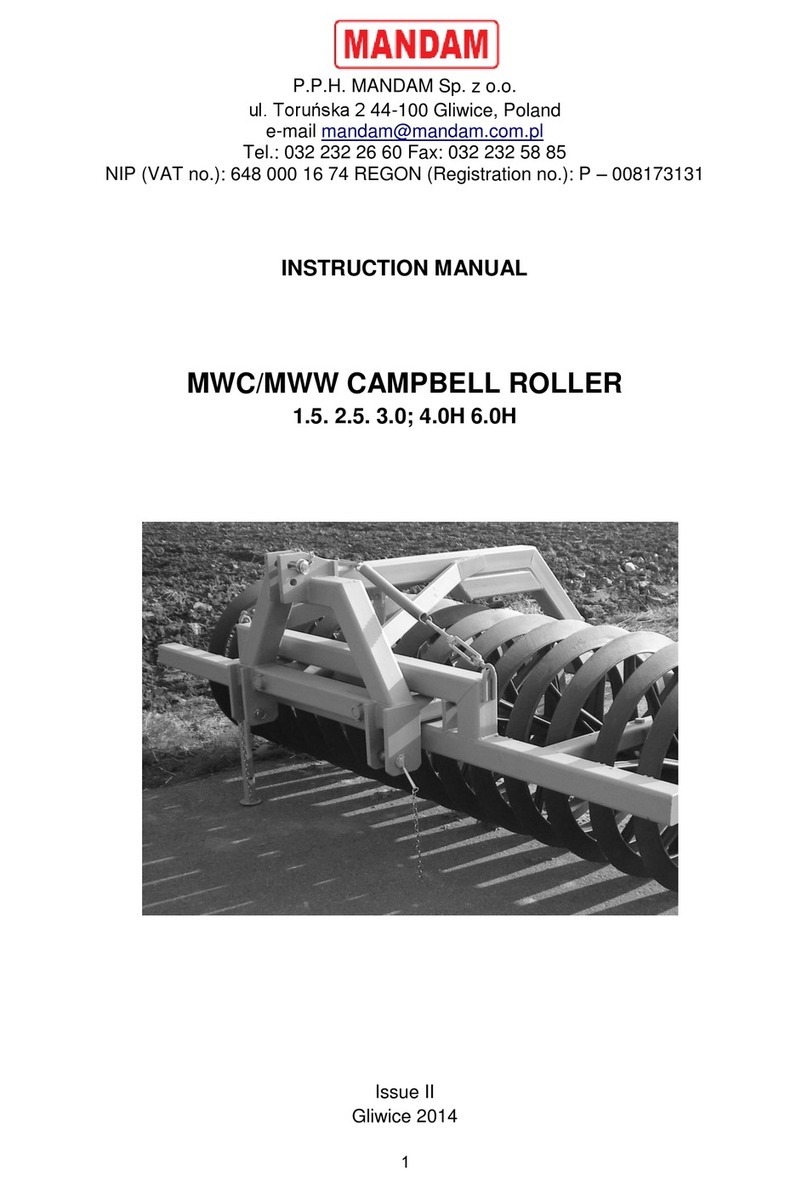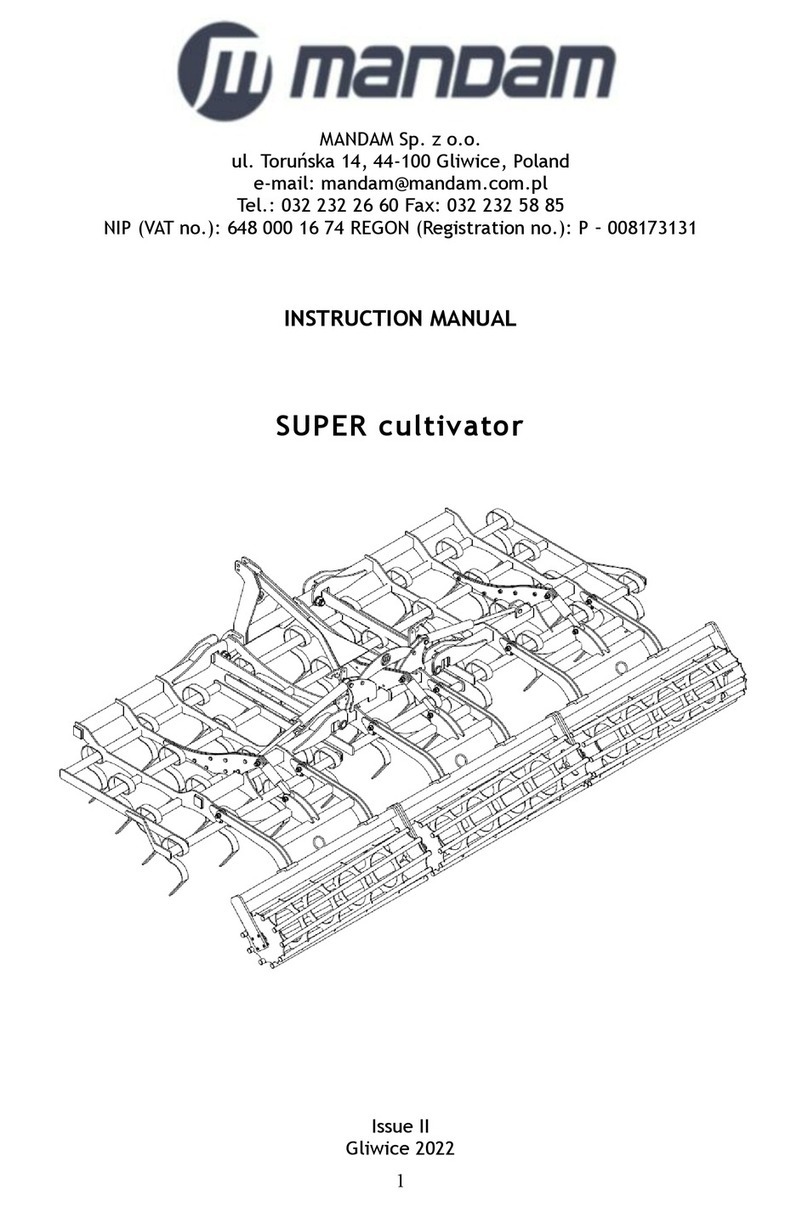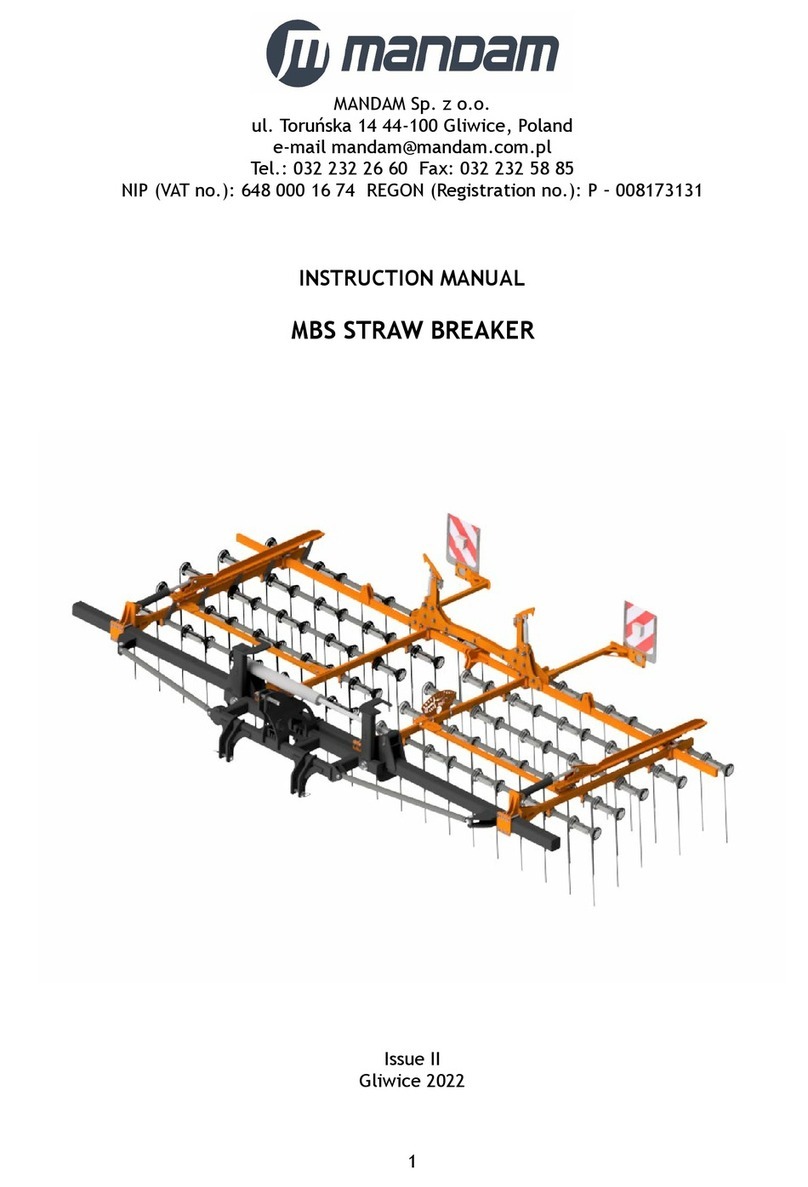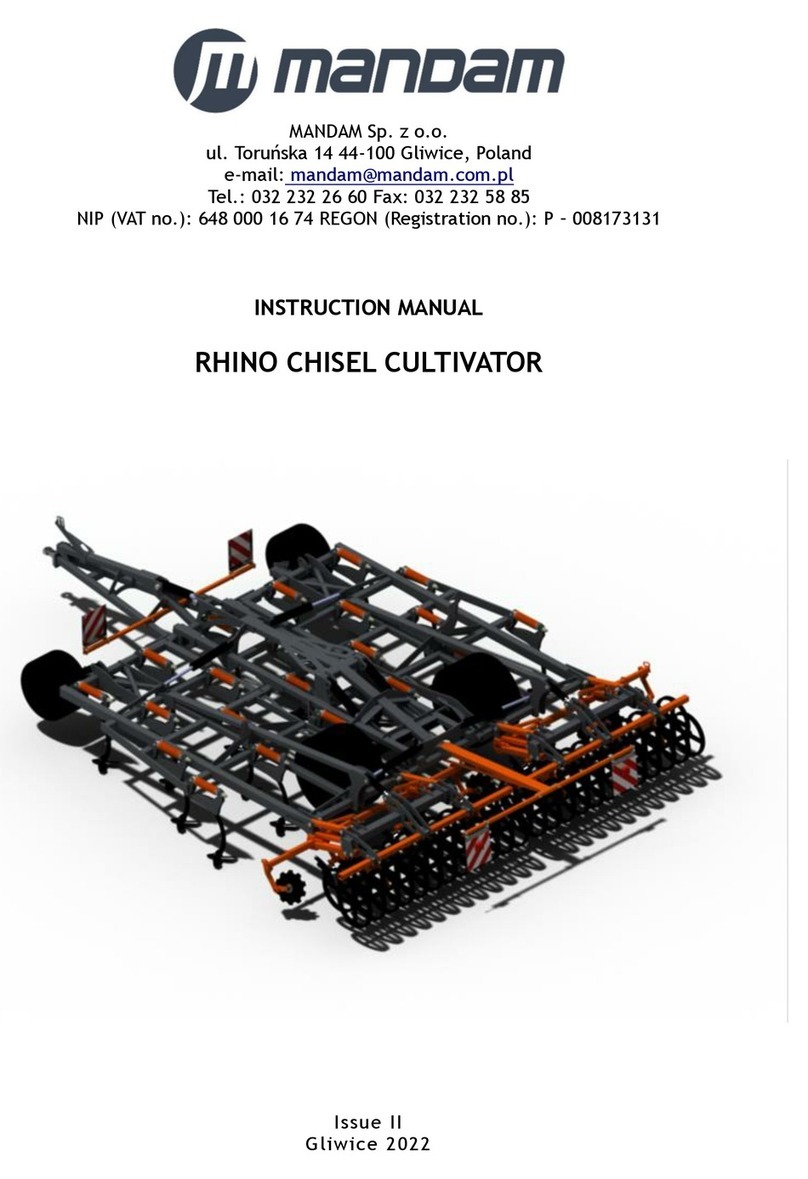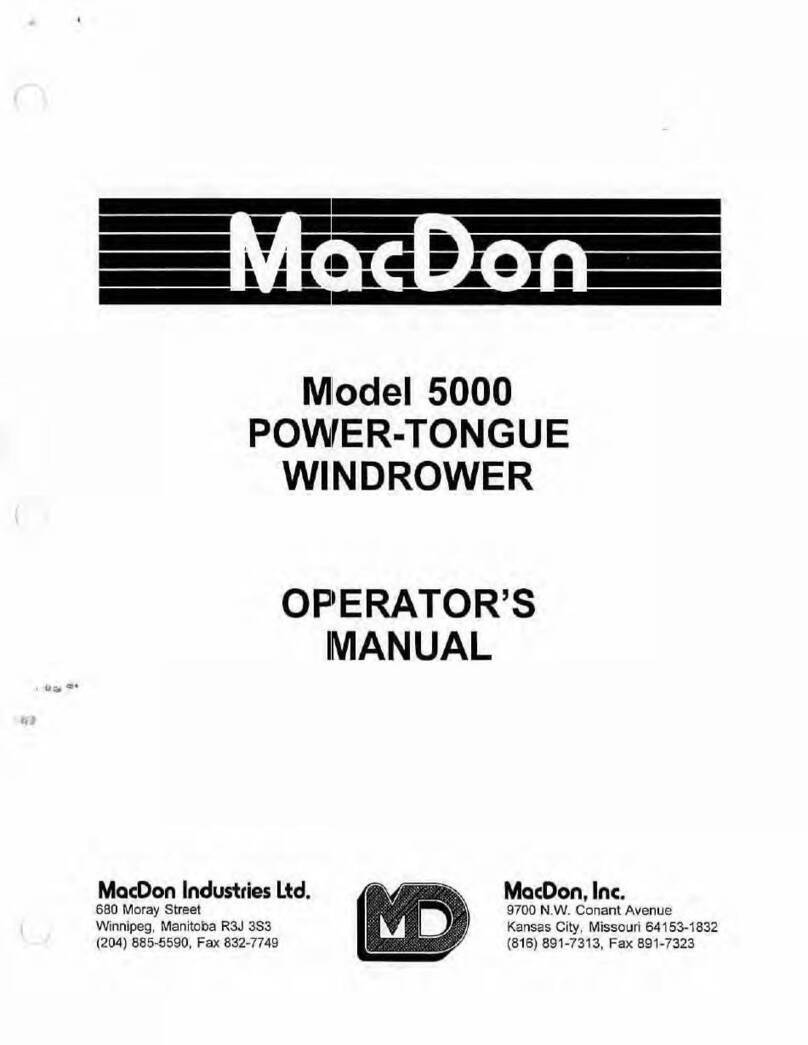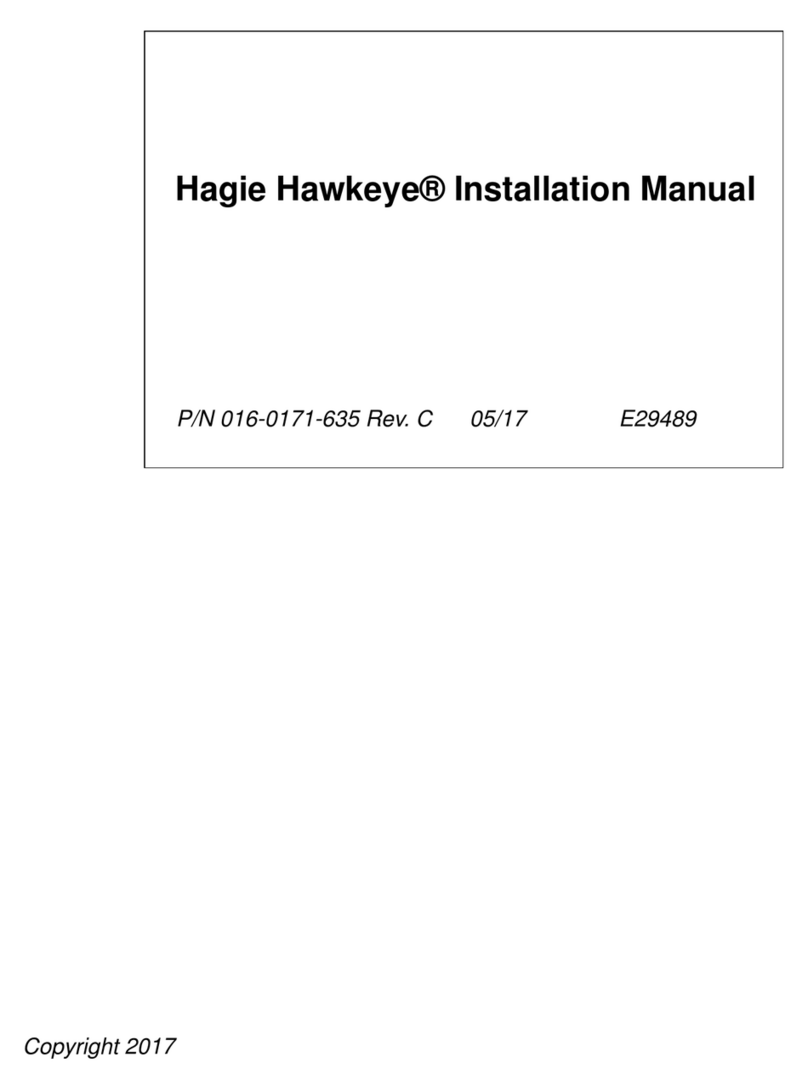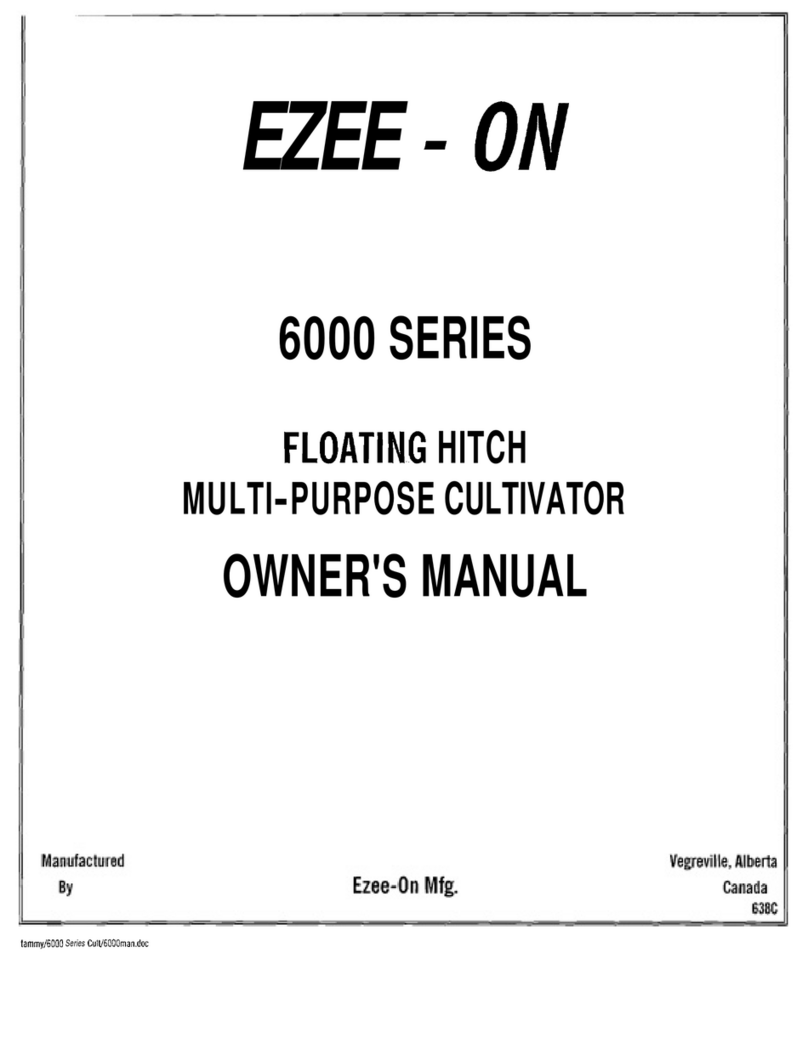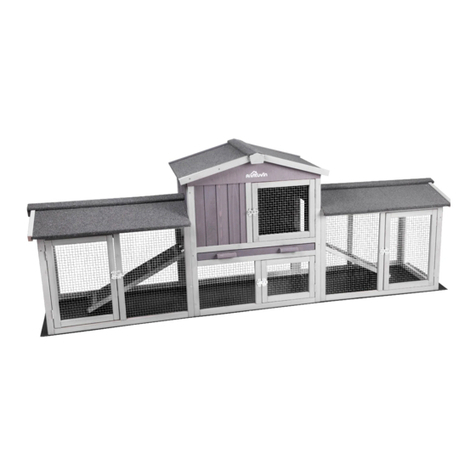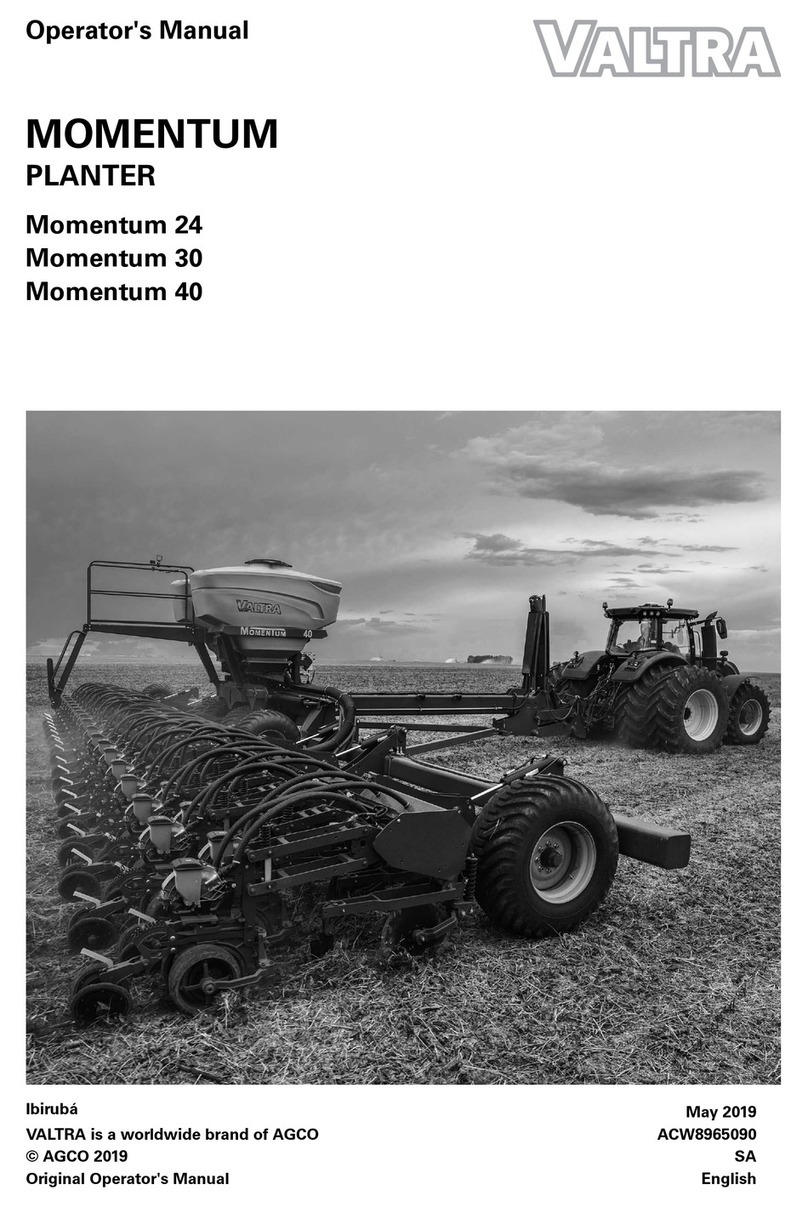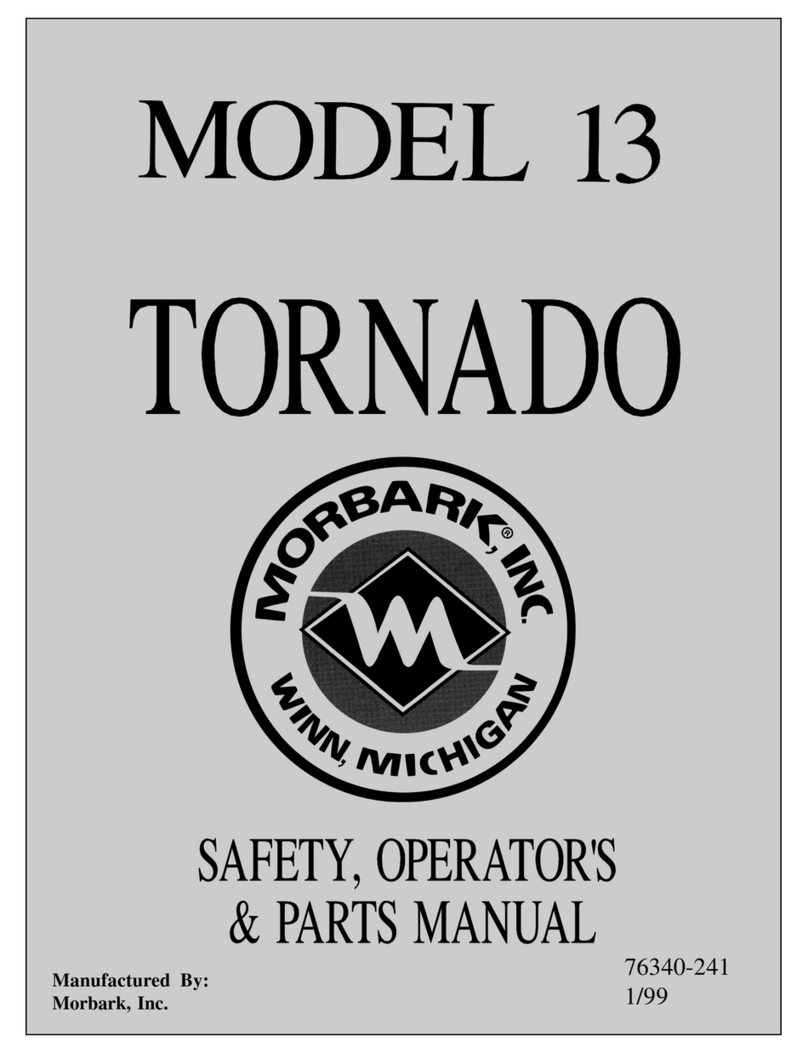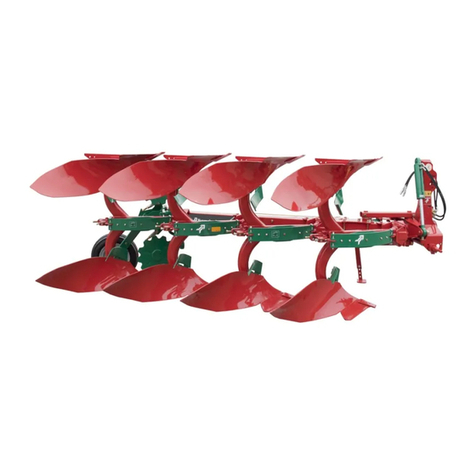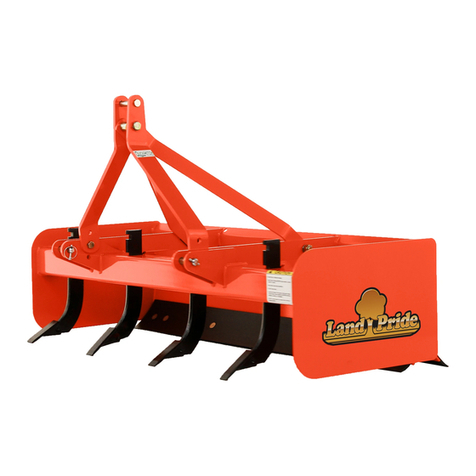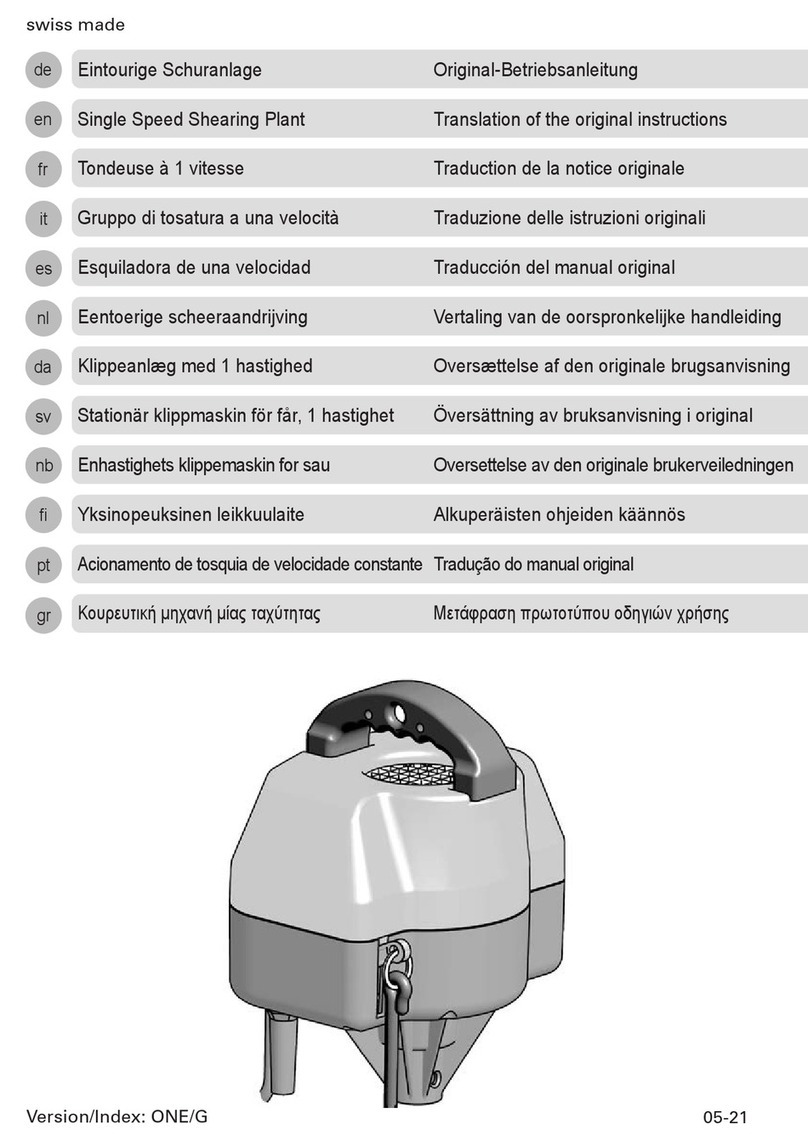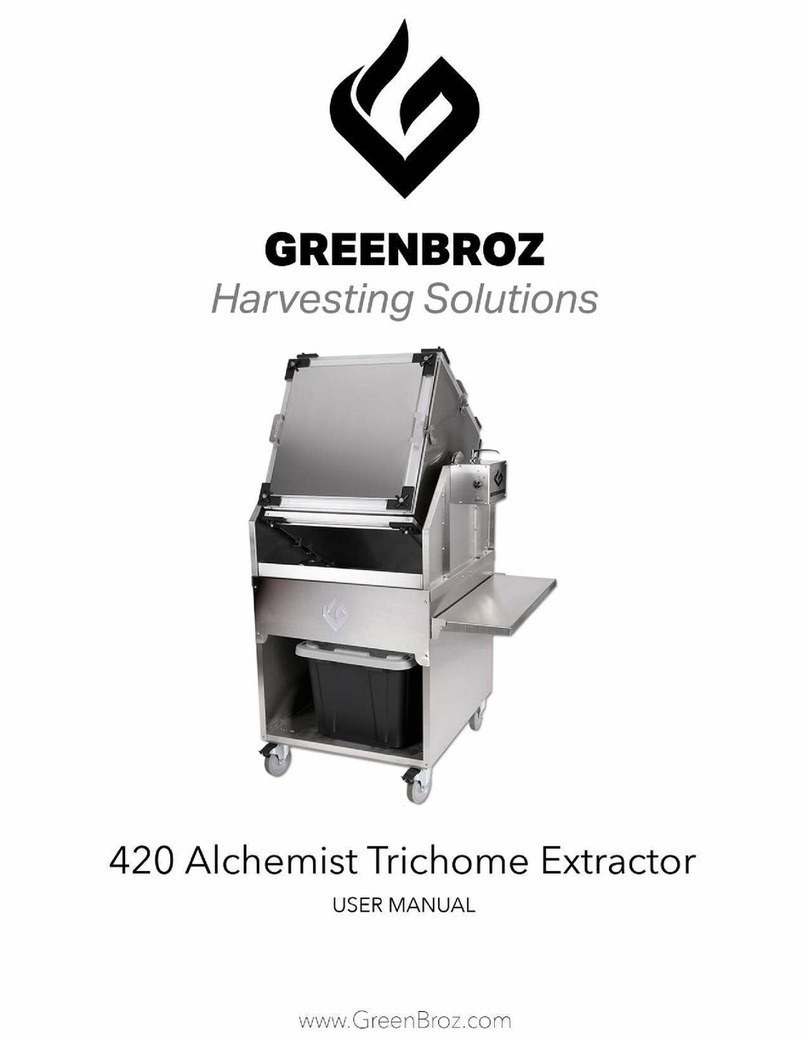Mandam KNIFE ROLLER 3.0 User manual

2
EC DECLARATION OF CONFORMITY
FOR A MACHINE
In accordance with the Ordinance of the Minister of the Economy dated 21 October 2008 (Journal of Laws No. 199, item
1228) and the Directive of the European Union no. 2006/42/EC of 17 May 2006
“MANDAM” Sp. z o.o.
ul. Toruńska 14
44-100 Gliwice
hereby declares at its sole responsibility that the following machine:
under this declaration, complies with:
the Ordinance ofthe Ministry of Economy of 21 October 2008 on fundamental
requirements for machinery (Journal of Laws No. 199, item 1228) and the Directive
of the European Union 2006/42/EC of 17 May 2006.
Persons responsible for the technical documentation for the machine: Jarosław Kudlek, Łukasz Jakus
ul. Toruńska 2, 44-100 Gliwice, Poland
For assessment of compliance the following standards have been applied:
PN-EN ISO 13857:2010
PN-EN ISO 4254-1:2016-02
PN-EN ISO 12100-1:2005/A1:2012
PN-EN ISO 12100-2:2005/A1:2012
PN-EN 982+A1:2008
This EC Declaration of Conformity shall be cancelled
if the machine is modified or redesigned without consent of the manufacturer.
……………………………………………… ………………………………………
Place and date of issue First and last name, position held and
signature of the person authorized
type/model: ……………………………..
serial number:
year of manufacture: ……………………

3
1. Introduction...................................................................................................................................4
1.1. Safety signs and inscriptions .................................................................................................5
2. General information......................................................................................................................7
2.1. Knife roller design.................................................................................................................7
3. General safety information .........................................................................................................13
3.1. Hitching with the tractor......................................................................................................14
3.2. Hydraulic system.................................................................................................................14
3.3. Transport on public roads....................................................................................................14
3.4. Description of residual risk .................................................................................................15
3.5. Residual risk assessment .....................................................................................................15
4. General information on the use of the implement ......................................................................16
4.1. Hitching the roller with the tractor ......................................................................................17
4.2. Operation and adjustment....................................................................................................18
4.2.1 Setting the knife direction .....................................................................................................18
4.3. Maintenance and lubrication ...............................................................................................20
5. Technical maintenance................................................................................................................21
5.1. Hydraulic system maintenance (knife roller H) ..................................................................21
5.2. Defects and malfunctions in the roller operation ................................................................22
6. Roller storage..............................................................................................................................23
7. Roller transport ...........................................................................................................................23
8. Disassembly and withdrawal from service and scrapping..........................................................24
9. Knife roller spare parts ...............................................................................................................24

4
1. Introduction
Congratulations on your purchase of the knife roller.
This instruction manual provides information on the hazards that may occur during use,
knife roller operation, technical data and the most important indications and
recommendations, the knowledge and use of which is a prerequisite for proper operation.
Keep this manual for future reference. Should you have any problems with understanding
any statement in the instruction manual, please contact the manufacturer.
The following mark indicates the guidelines that are important due to safety reasons:
Machine identification
Identification data of the roller, including basic information on the manufacturer and the
machine and CE marking, can be found on the rating plate placed on the load-bearing
frame.
The warranty for the knife roller is valid for 24 months and runs from the date of sale.
The warranty card constitutes an integral part of the machine.
Always provide the serial number when submitting inquiries for spare parts.
For more information on spare parts:
•please visit our website at: http://mandam.com.pl/parts/
•call us at +48 668 662 289
•e-mail us at: czesci@mandam.com

5
1.1. Safety signs and inscriptions
Remember! Special care must be taken when using the roller in case of areas
marked with special information and warning signs (yellow stickers).
The following symbols and inscriptions can be found on the implement. Secure the signs
and inscriptions against loss and make sure they are legible at all times. If lost or illegible,
replace the signs and inscriptions with new ones.
Table 1. Information and warning signs
Safety sign
Meaning of the safety sign
Location on the implement
Read the instruction manual
prior to operating the
implement.
Frame adjacent to the
mounting place of the upper
fastener
Danger of toe or foot crush.
Frame adjacent to the
mounting place of the upper
fastener
Keep clear from lift bars
while controlling the lift.
Frame adjacent to the
mounting place of the upper
fastener
Keep clear from foldable
and moving parts of the
implement.
Front part of the mid frame
adjacent to side frames

6
Safety sign
Meaning of the safety sign
Location on the implement
Do not reach into the
crushing zone if the
elements can move
Middle frame adjacent to
side frames
Pressurized fluid – hazard of
bodily injury
Cylinders
Fixing point for transport
belts
Upper part of the drawbar
(upper fastener bolt)
Rear part of the frame:
•rigid frame (adjacent
to the roller depth
adjustment)
•foldable frame
(adjacent to the
cylinder bolt on the
mid frame)

7
2. General information
2.1. Knife roller design
Knife rollers are available in single and tandem versions, in the working widths of 3.0 m,
3.5 m, 4.0 m, 5.0 m and 6.0 m.
Fig. 1 Knife roller 3.0
roller rubber protection
knife roller
top hitch connector
drawbar
support foot
roller angle adjustment
adapter or unit connector
front three-point hitch adapter

8
Table 2. Single knife rollers
Typ e
Working width
[m]
Roller diameter
[mm]
Min. power
demand [HP]
Weight
[kg]
KNIFE ROLLER 3.0
3
380
30
552
KNIFE ROLLER 3.5
3.5
380
35
644
KNIFE ROLLER 4.0
4
380
40
920
KNIFE ROLLER 4.0 H
4
380
40
968
KNIFE ROLLER 5.0 H
5
380
50
1102
KNIFE ROLLER 6.0 H
6
380
60
172
Table 3. Tandem knife rollers
Typ e
Working width
[m]
Roller diameter
[mm]
Min. power
demand [HP]
Weight
[kg]
TANDEM KNIFE ROLLER 3.0
3
460
60
800
TANDEM KNIFE ROLLER 3.5
3.5
460
65
933
TANDEM KNIFE ROLLER 4.0
4
460
80
1060
TANDEM KNIFE ROLLER 4.0 H
4
460
80
1180
TANDEM KNIFE ROLLER 5.0 H
5
460
100
1390
TANDEM KNIFE ROLLER 6.0 H
6
460
120
1600
Table 4. Tandem knife rollers HD
Typ e
Working
width [m]
Roller diameter
[mm]
Min. power
demand [HP]
Weight
[kg]
TANDEM KNIFE ROLLER HD 3.0
3
560
60
1020
TANDEM KNIFE ROLLER HD 3.5
3.5
560
65
1260
TANDEM KNIFE ROLLER HD 4.0
4
560
80
1330
TANDEM KNIFE ROLLER HD 4.0 H
4
560
80
1520
TANDEM KNIFE ROLLER HD 5.0 H
5
560
100
1770
TANDEM KNIFE ROLLER HD 6.0 H
6
560
120
1980

9
The single knife rollers 3.0, 3.5 and 4.0 are not foldable and are attached to the front or
rear tractor three-point hitch. When attached to the rear three-point hitch, it is possible
to suspend an additional unit behind the roller, e.g. a disc harrow. The front three-point
hitch adapter should be removed in such case and an additional unit should be attached
in its place using bolts.
The Tandem foldable knife rollers in the working width of 4.0, 5.0 and 6.0 are adapted to
be attached to the front three-point hitch. They also feature a floating drawbar stabilized
with springs. When the pins are properly interlocked and the working rollers are rotated,
it is possible for the roller to work on the tractor’s rear hitch.
The single and tandem knife rollers with working widths 4.0H, 5.0H and 6.0H have a middle
frame and lateral frames which are hydraulically folded to the transport position (Fig. 3
and 4).

10
Fig. 2 Tandem knife roller 3.0
stabilizing spring
top hitch
floating position locking bolt
bottom hitch
ø460 roller 7 knives
on the perimeter
ø460 roller 8 knives
on the perimeter

11
Fig. 3 Knife roller 4.0 H
hydraulic system stabilizing spring
roller rubber protection ø380 knife roller
top hitch
bottom hitch
roller angle adjustment
support foot

12
Fig. 4 Tandem knife roller HD 4.0 H
2.2 Intended use of the knife roller
The knife roller is used for an intensive shredding of straw and post-harvest crop
residue, along with crushing and partial covering. This speeds up the decomposition of
crop residue, facilitating further post-harvest cultivation. The knife roller is also a perfect
tool for fighting the European corn borer.
The working part of the roller is an openwork drum with cutting knives bolted on its
circumference. The knives are made of the HARDOX wear resistant steel. The knives
should operate on the field surface. The knife roller shall not penetrate into the soil
deeper than 2-3 cm.
hydraulic system stabilizing spring center frame
top cover
floating position
locking bolt
top hitch
bottom hitch
ø560 Roller
7 doubled knives on the perimeter
ø560 Roller
8 doubled knives on the perimeter

13
CAUTION! The roller is designed for agricultural use only. Using the
implement for tasks that differ from the intended use shall be regarded as
misuse, resulting in loss of warranty.
CAUTION! Failure to follow the guidelines included in this instruction manual
shall be regarded as misuse. The manufacturer shall not be liable for any
damage arising out of misuse.
As an option, single and tandem knife rollers can be equipped with frame-mounted
upper covers to protect the tractor from the spread of post-harvest crop residue or
stones caused by the working rollers. On tandem knife rollers HD, these protection
covers are mounted on the machines as standard.
Fig. 5 Tandem knife roller 3.0 with upper protection covers
3. General safety information
The roller can be operated and repaired only by persons familiar with its operation and
the attached tractor as well as the rules of safe operation and maintenance of the knife
roller. The manufacturer shall not be responsible for any arbitrary modifications of the
construction of the roller. Only genuine MANDAM spare parts shall be used during the
warranty period.
The roller must be operated with all precautionary measures, in particular:
•each time before starting operation check the roller and the tractor whether their
condition guarantees safety during operation and travel,
•minors, disabled or intoxicated persons (under the influence of alcohol or drugs)
must not operate the machine,
•wear work clothes, shoes and gloves during maintenance,
•do not exceed permissible axle and tyre loads or transport dimensions,
•use only original cotter pins and pins,
•do not approach the roller while it is being lifted or lowered,
•do not stay between the roller and the tractor while the engine is running,

14
•move forward, lift, and lower the roller slowly and smoothly without sudden jerks,
making sure that nobody stays in the vicinity,
•do not reverse and make U-turns when the implement is lowered to the working
position,
•when making U-turns do not use independent tractor brakes,
•do not stand on the implement or apply additional loads during operation and
transport,
•while making U-turns, pay due caution if anyone is in the vicini t y,
•do not operate the roller on slopes with the inclination exceeding 12°,
•any repairs, lubrication or cleaning of working components may be performed as
long as the engine is not running and the roller is lowered,
•There is a hazard of head injury when you perform maintenance or replacement of
parts under the implement without adequate protection – wear a hardhat,
•during a break in the work, always lower the implement to the ground and stop the
tractor engine,
•foldable rollers have a mechanical lock that prevents an uncontrolled lowering of
the side extensions,
•driving and parking the implement on an unstable slope may cause sliding and soil
slipping,
•store the implement in a manner preventing injury to people and animals.
3.1. Hitching with the tractor
•Hitch the implement with the tractor according to the recommendations, use pins
and protect the pins with cotter pins.
•While hitching the tractor with the roller, do not stay between the implement and
the tractor.
•The tractor used together with the roller must be fully functional and in good
working order. Do not attach the implement to a tractor with a defective hydraulic
system.
•Remember to observe the following: balance of the tractor and the suspended
implement, tractor steerability and braking performance – the front axle load must
not drop below 20% of the total tractor load – a kit of front weights.
•In the rest position the implement unhitched from the tractor shall maintain a
stable balance.
•The supporting foot should be used on a stable ground. Do not use supporting plates
under the foot as this may cause instability of the support.
3.2. Hydraulic system
The hydraulic system operates under high pressure. Take all precautionary measures, in
particular:
•do not connect and disconnect hydraulic hoses when the tractor hydraulic system is
pressurised (hydraulics set to neutral),
•regularly check the conditions of connections and hydraulic hoses,
•do not use the implement until the hydraulic system is repaired.
3.3. Transport on public roads
Before driving on public roads, fold the lateral sections of knife rollers 4.0H, 5.0H and
6.0H to the travel position using the hydraulic system. Before folding, the machine must
be lifted sufficiently high until the folded side sections do not collide with the ground.
The knife roller must be protected against unfolding by means of the mechanical lock.

15
The clearance under the implement during the drive shall be at least 30 cm.
While transporting the implement on public roads, it is absolutely mandatory to use lights,
an identification sign and reflective side lights.
Do not exceed the maximum travel speeds:
–up to 20 km/h on smooth-surface (asphalt) roads,
–6-10 km/h on country roads or cobblestones,
–up to 5 km/h on bumpy roads.
Adapt the drive speed to the road conditions to prevent the roller jumping on the three-
point hitch and to prevent excessive loads on the implement frame and the three-point
hitch.
Act with due caution when passing and overtaking or travelling at curves. The permissible
width of the agricultural machinery moving on public roads is 3.0 m.
WARNING! Any failure to observe the above rules may pose hazard to the
operator and other people. It may also result in damaging the machine. The
user shall be liable for any damage caused by failure to observe the rules!
3.4. Description of residual risk
Mandam Sp. z o.o. makes every effort to eliminate the risk of accidents. However, there
is some residual risk that may result in an accident. The biggest hazard occurs
when/during:
•using the implement for purposes other than described in the manual,
•operating the implement by people who are underage and do not have licences,
are ill or intoxicated,
•presence of people and animals within the implement operating range,
•precautionary measures are not taken during transport and maneouvering with the
tractor,
•staying on the implement or between the tractor and the implement when the
motor is running,
•maintenance and when the service recommendations are not observed,
•driving on public roads.
3.5. Residual risk assessment
The residual risk can be minimized by applying the following recommendations:
•operate the implement carefully and without undue haste,
•read the instruction manual carefully,
•keep a safe distance from hazard zones,
•do not stay on the implement and within the implement operating range when the
engine is running,
•perform the maintenance in accordance with safety rules,
•wear safety clothes and a safety helmet while working under the implement;
•prevent the access of unauthorized personnel and especially children to the
implement.

16
4. General information on the use of the implement
Before the machine is put into operation for the first time:
•read the instruction manual,
•make sure that the machine is in proper operating condition,
•check the condition of the hydraulic system (replace damaged components, e.g.
pressure hoses),
•make sure that the hydraulic hose quick-connector of the machine match the
tractor sockets,
•check the tightening of bolts and nuts,
•check if the air pressure in tyres is according to the manufacturer’s
recommendations,
•make sure that all components requiring lubrication are lubricated,
•make sure the tyre pressure in the tractor wheels is equal on both axes to ensure
even operation.
WARNING! Do not exceed the maximum permissible axle and tyre loads. The
front axle load must not be less than 20% of the total load. Tyre pressure
must comply with the values recommended by the manufacturer.
Fig. 6 Diagram with markings of tractor loads.
Axle load calculations
Key:
GC– tractor’s gross weight,
TP – front axle load for the unhitched tractor,
TT– rear axle load for the unhitched tractor,
GP– total weight of the front-mounted implement,
GT– total weight of the rear-mounted implement,
a – distance between the centre of gravity of the front-mounted implement and the axle
centre,
b – tractor wheelbase,
c – distance between the rear axle centre and the centre point of the hitching pin of the
rear-mounted implement,

17
d – distance of the centre of gravity of the agricultural implement from the hitching pins
of the tractor (assume 1.9 m for all widths),
x – distance of the centre of gravity from the rear axle (assume 0.45 if the manufacturer
does not provide this parameter).
Minimum load at the front in case of a rear-mounted implement:
=
⋅(+)−
⋅ + 0.2 ⋅ ⋅
+
Minimum load at the rear in case of a front-mounted implement:
=
⋅ − ⋅ + ⋅ ⋅
++
Actual load on the front axle:
ł=
⋅(+) +
⋅ − ⋅(+)
Actual total weight:
ł=++
Actual load on the rear axle:
ł=ł−
ł
4.1. Hitching the roller with the tractor
Tyre pressure in the tractor wheels must comply with the values recommended by the
manufacturer. The lower bars of the three-point hitch should be at the same height,
spaced correspondingly to the spacing of the lower points of suspension. While attaching
the roller to the tractor, the implement must be placed on hard and even ground.
Fig. 7 Three-point hitch of the tractor: 1,2 – lower bars, 3 – upper fastener, 4 – left support rail, 5 – right
support rail with adjustable length, 6 – lift arm, 7 – lift shaft
While attaching the roller to the three-point hitch of the tractor, follow the steps as
below:
•switch the tractor hydraulic system into adjustment position,

18
•remove lower hitch bolts (if the tractor lift is not equipped with hooks),
•drive forwards carefully, suspend the implement on the lower bars and secure,
•attach the tractor’s upper fastener. During operation of the unit, the hitch point of
the upper fastener at the unit must be located higher than the attachment point
of this fastener at the tractor,
•check the operation of roller lifting, lowering and the hydraulic system.
CAUTION! Hitching the tractor with the roller must be performed carefully,
at the tractor’s minimum speed! When hitching the implement, make sure
that no bystanders are present in the vicinity.
4.2. Operation and adjustment
Start working with the roller by making the first trial passage. During this task, check
roller adjustment and manner of operation. If necessary, adjust the length of the tractor
fastener so that the roller frame is positioned horizontally. The working depth of the knife
roller is adjusted by means of the turnbuckles (Fig. 8). The knives should operate on the
field surface. The knife roller shall not penetrate into the soil deeper than 2-3 cm. The
working speed on the field with the roller attached should not exceed 15 km/h. A correctly
hitched and adjusted roller should evenly travel before or behind the tractor and evenly
shred the post-harvest residue at its entire working width.
Fig. 8 Knife roller working depth adjustment
4.2.1 Setting theknife direction
Tandem knife rollers in 3.0 m, 3.5 m and 4.0 m widths in the non-folding version are
factory-prepared for both front-and rear-mounted operation using the tractor’s three-
point hitch. When attached to the rear three-point hitch, it is possible to suspend an
additional unit behind the roller, e.g. a disc harrow. The front three-point hitch adapter
should be removed in such case and an additional unit should be attached in its place
using bolts.
The Tandem foldable knife rollers in the working width of 4.0, 5.0 and 6.0 are adapted to
be attached
Roller angle adjustment

19
to the front three-point hitch. They also feature a floating drawbar stabilized with
springs. When the pins are properly interlocked and the working rollers are rotated, it is
possible for the roller to work on the tractor’s rear hitch.
Fig. 9 Setting the tandem knife roller for front hitch operation
In order for the implement to work properly on the rear hitch, the floating position locking
bolt must be locked and the rollers must be turned to ensure the correct direction of the
knife (Fig. 11).
Fig. 10 Incorrect positioning of the tandem knife roller for rear hitch operation
correct direction of the knife
locking bolt
Driving direction
Driving direction
Incorrect direction of the knife

20
Fig. 11 Correct positioning of the tandem knife roller for rear hitch operation
CAUTION! Do not operate the roller on stony soil because the working
elements on the roller may become cracked.
CAUTION! The knife roller shall not penetrate into the soil deeper than 2-3
cm as this can cause an excessive wear of the roller working parts. The roller
should operate on the surface of the field.
CAUTION! Folding rollers cannot work on the rear hitch without proper
preparation by interlocking the locking pin and rotating the working rollers
accordingly.
4.3. Maintenance and lubrication
•Clean the knife roller from soil after each use and inspect the parts and assemblies.
Otherwise, there may be a problem with the folding of the machine if the rollers are
clogged with earth and there is an additional load!
•After the first 4 hours of operation, re-tighten all bolts and periodically check them
for tightness. Failure to do so will exacerbate play and backlash and result in damage
to the implement.
•Lubricate the lubrication points on the hinge bolts daily during the machine's service
life.
•Use thread adhesive and only genuine screws and nuts when replacing worn parts.
•Always remember to tighten the screwed joints properly.
CAUTION! Periodic lubrication guarantees the long service life of the machine.
Driving direction
locking bolt
correct direction of the knife
This manual suits for next models
17
Table of contents
Other Mandam Farm Equipment manuals
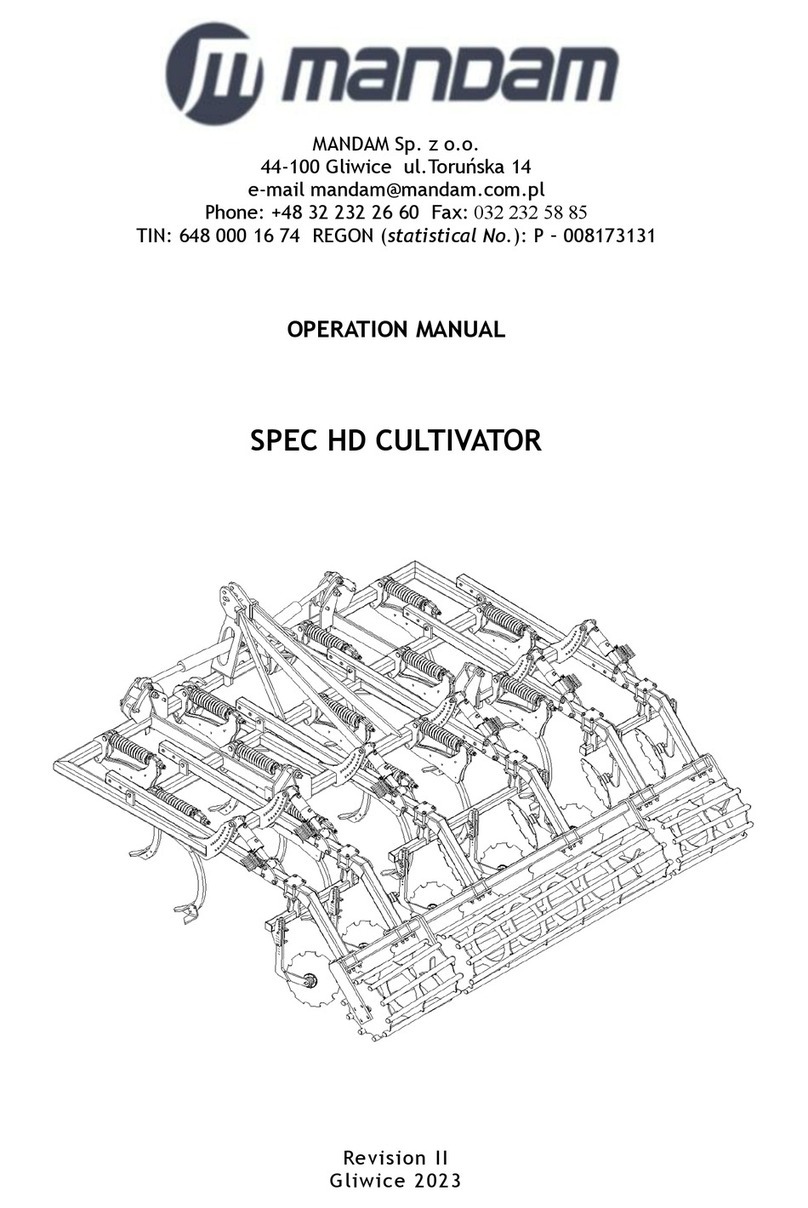
Mandam
Mandam SPEC HD 2,5 User manual

Mandam
Mandam MCH Series User manual
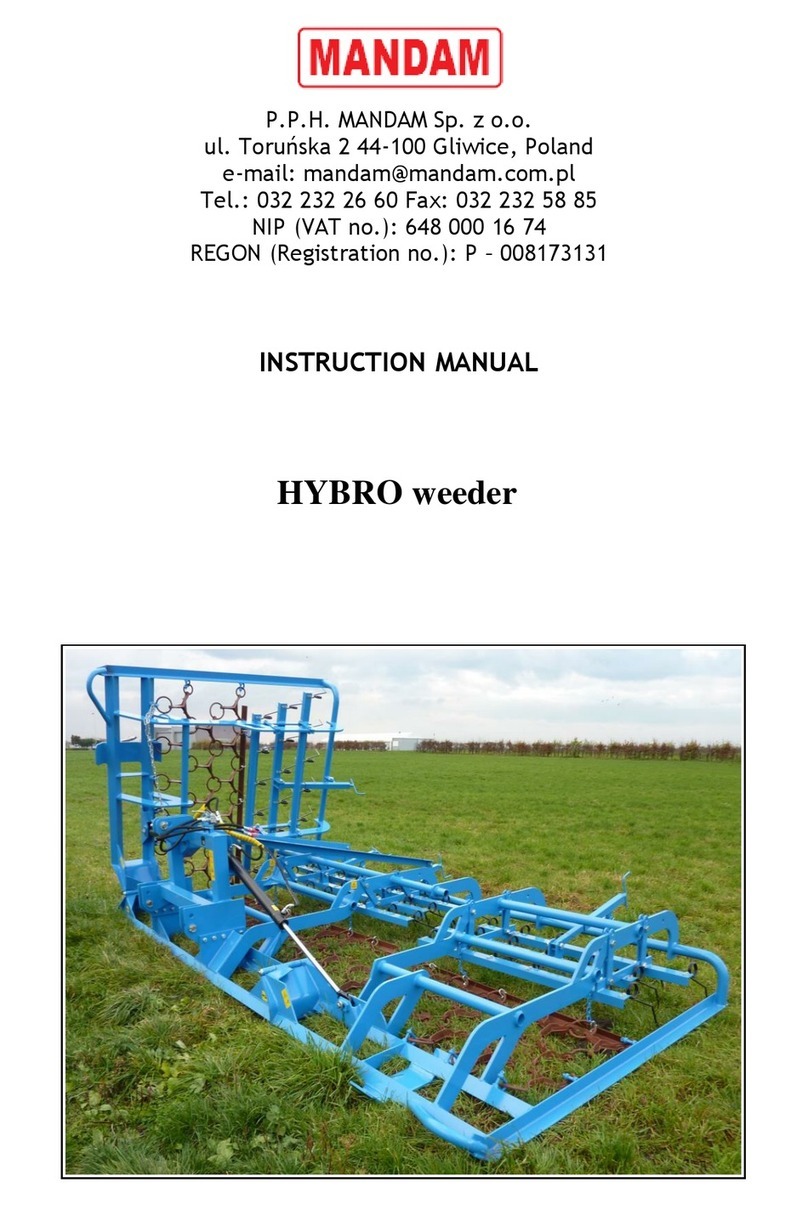
Mandam
Mandam Hybro 3,0 User manual
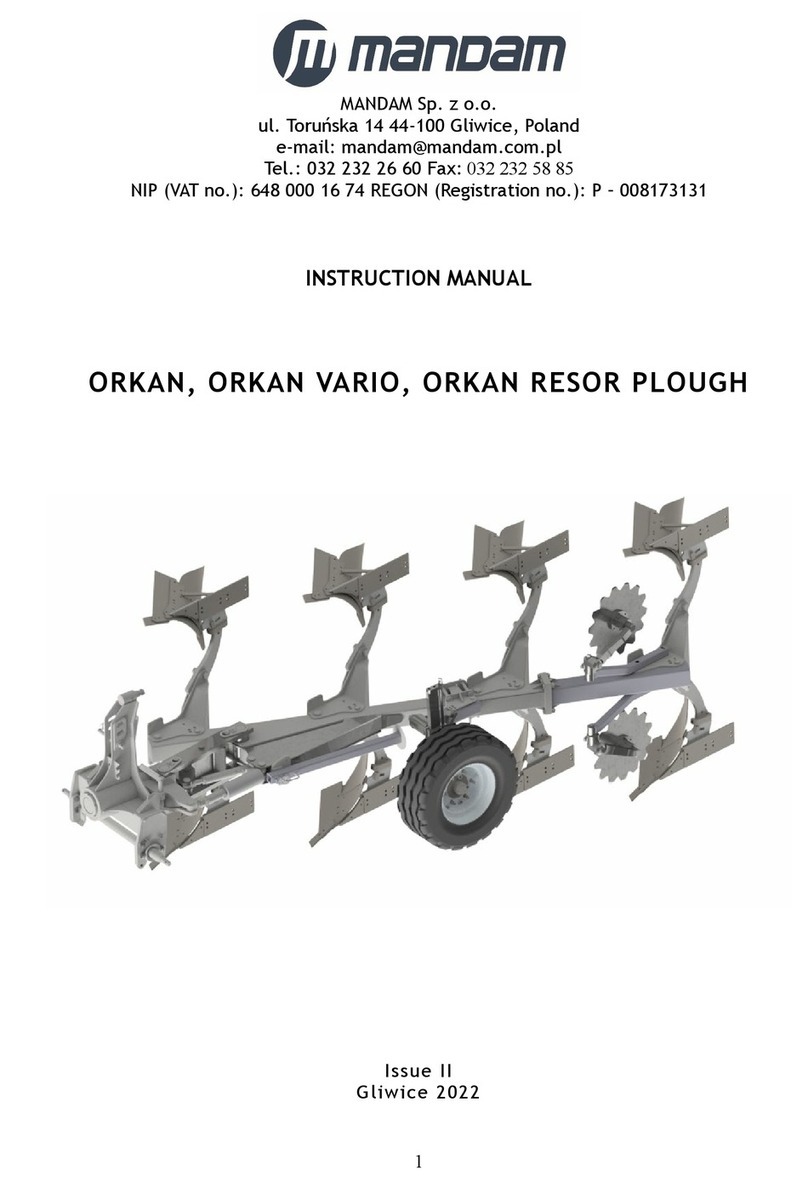
Mandam
Mandam ORKAN 3+ User manual
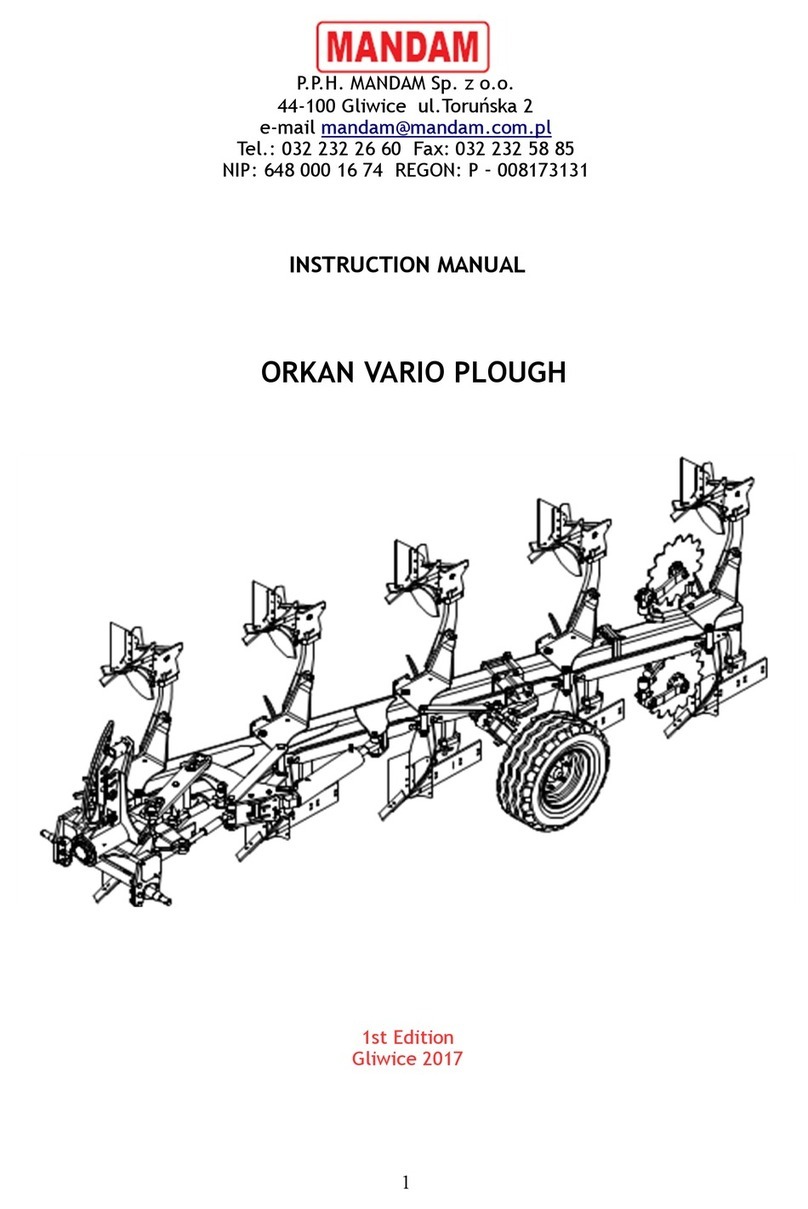
Mandam
Mandam ORKAN VARIO Series User manual
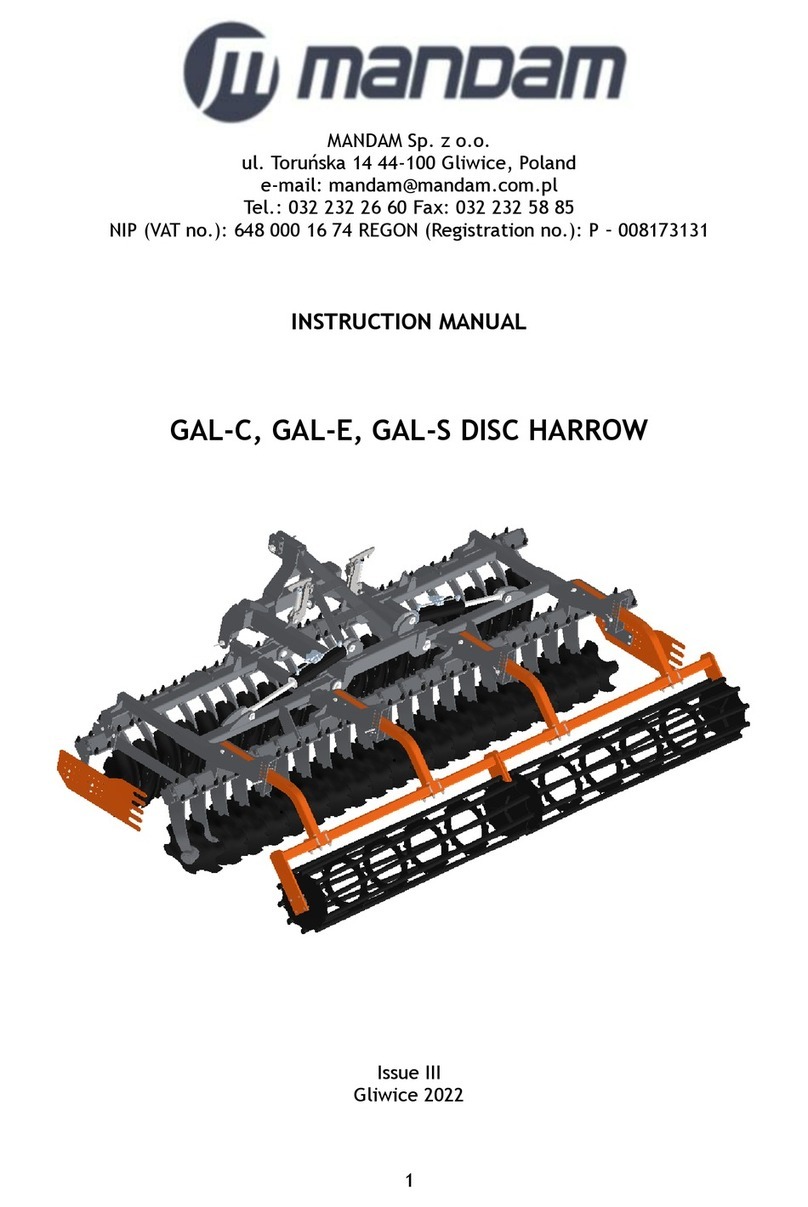
Mandam
Mandam GAL-C User manual

Mandam
Mandam GAL-K User manual
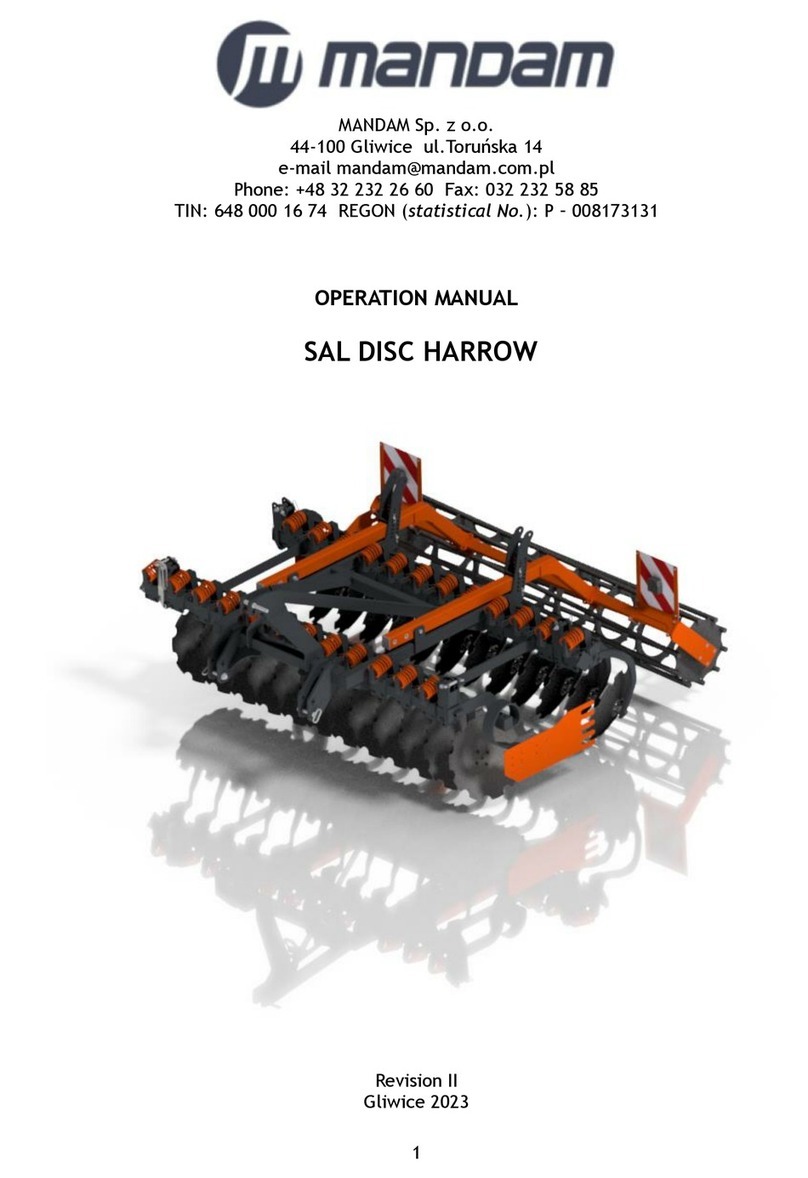
Mandam
Mandam SAL DISC HARROW User manual
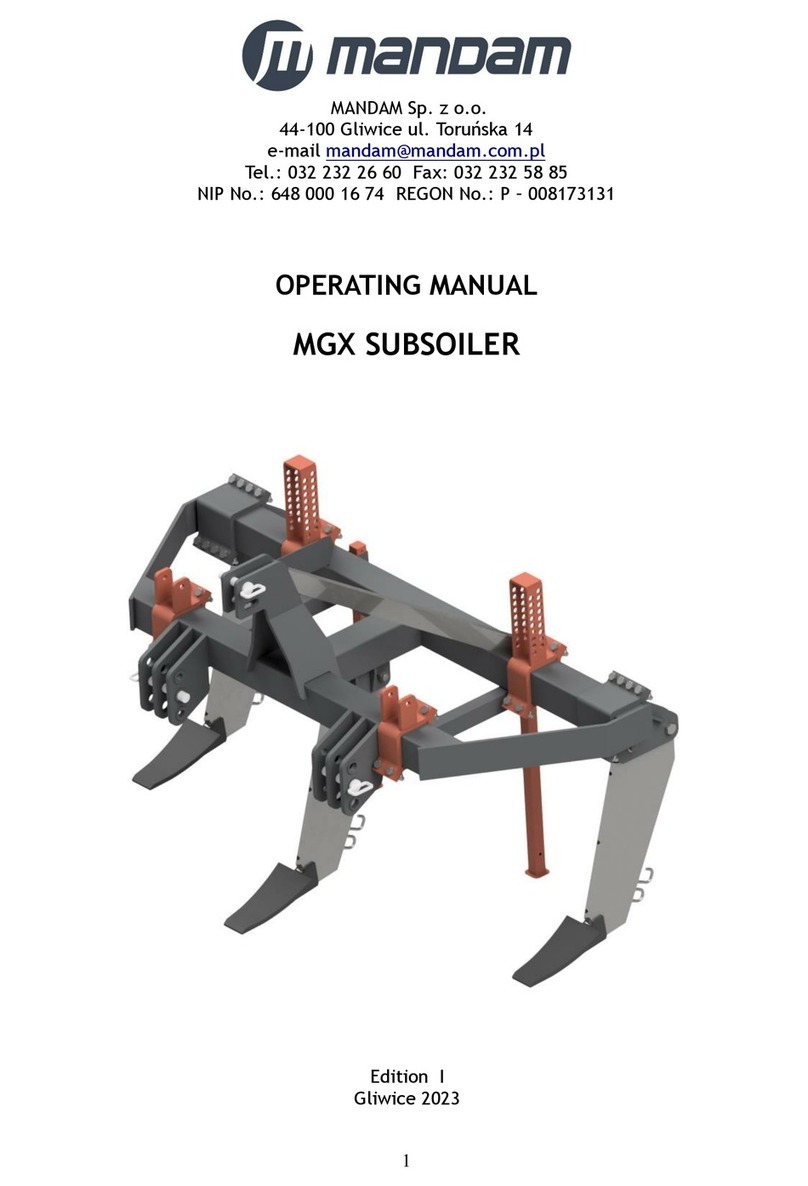
Mandam
Mandam MGX 2200 User manual
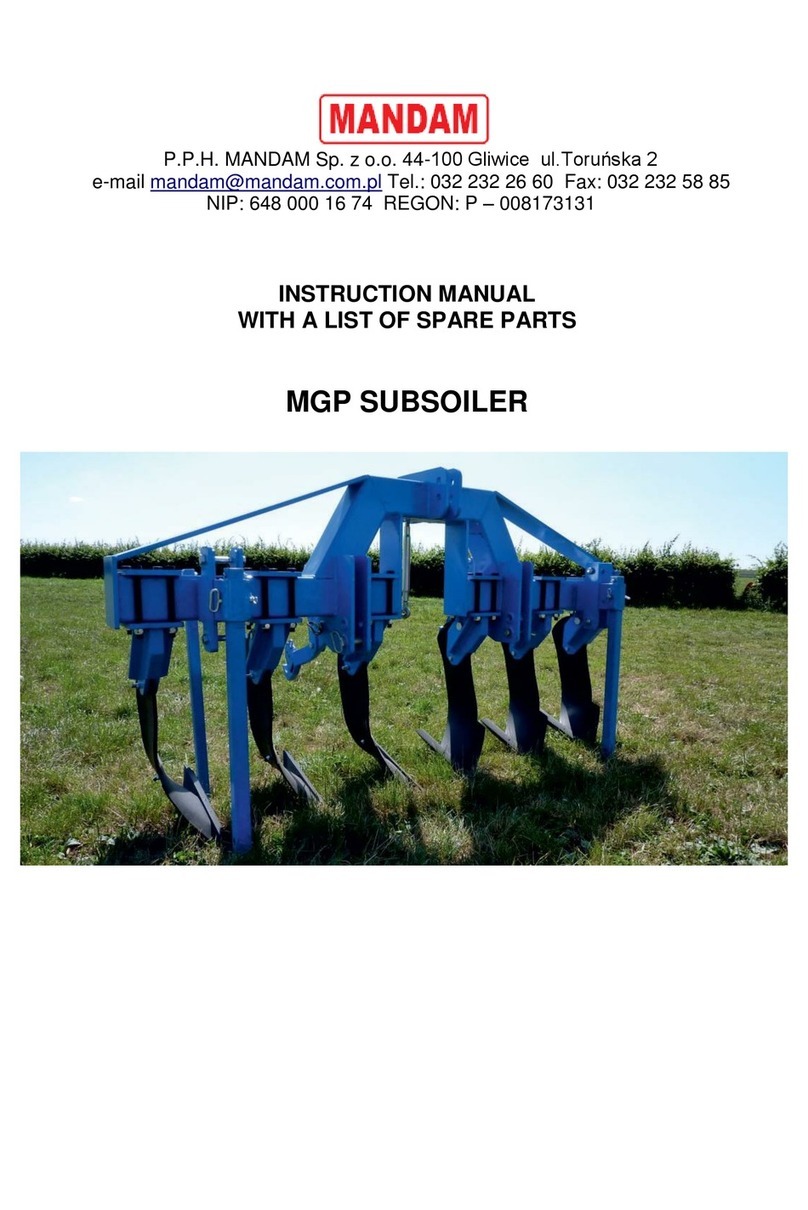
Mandam
Mandam MGP Series User manual
Popular Farm Equipment manuals by other brands

Standen
Standen ZENO Series manual
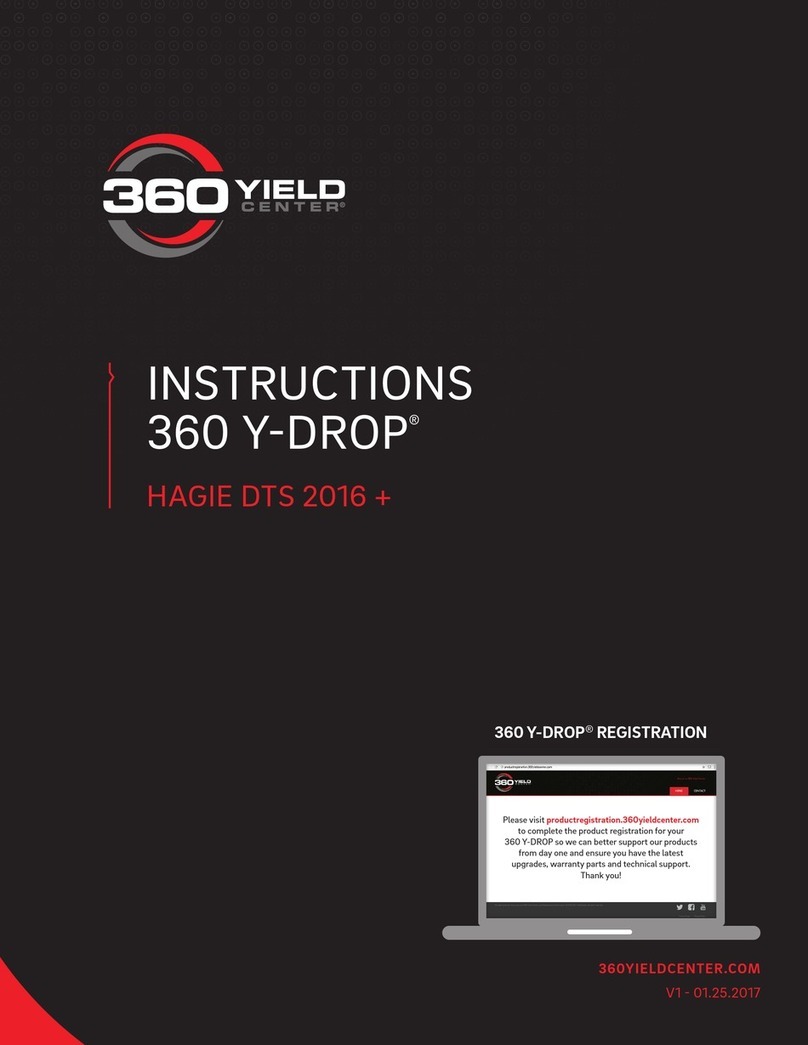
360 Yield
360 Yield 360 Y-DROP HAGIE DTS 2016 + instruction manual
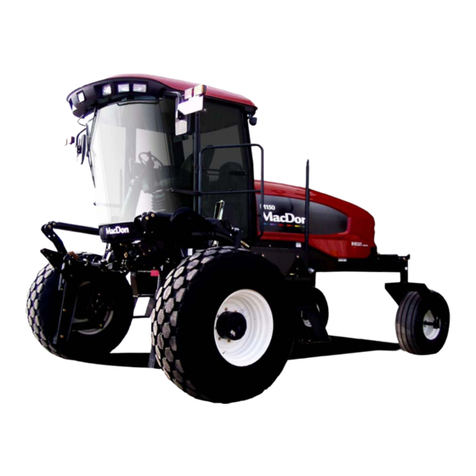
MacDon
MacDon M150 2008 Operator's manual
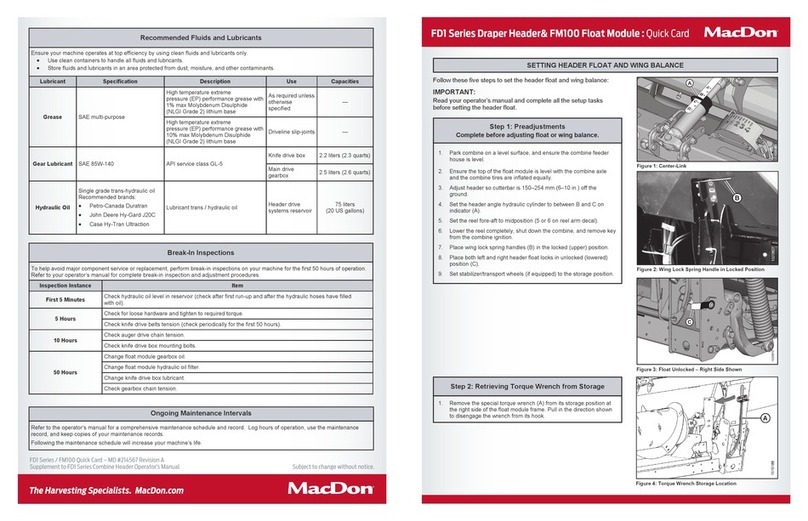
MacDon
MacDon FlexDraper FD1 Series Quick Card
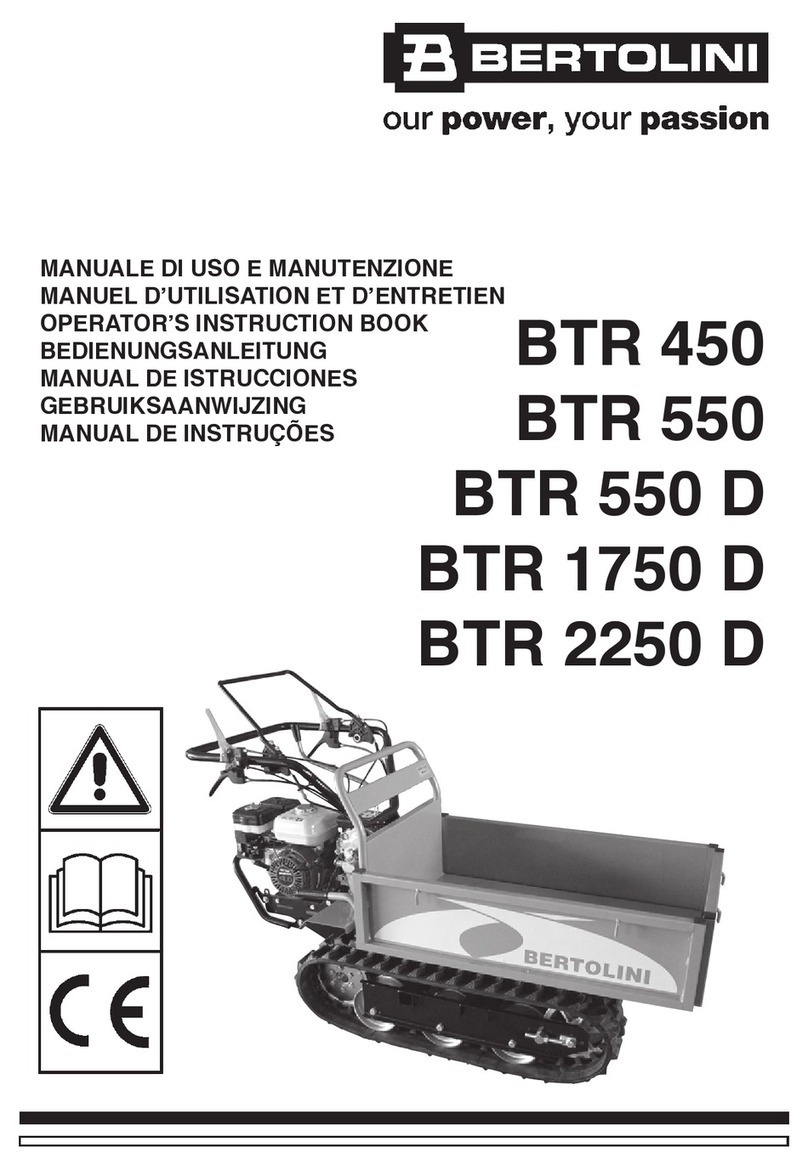
Bertolini
Bertolini BTR 450 Operators instruction book
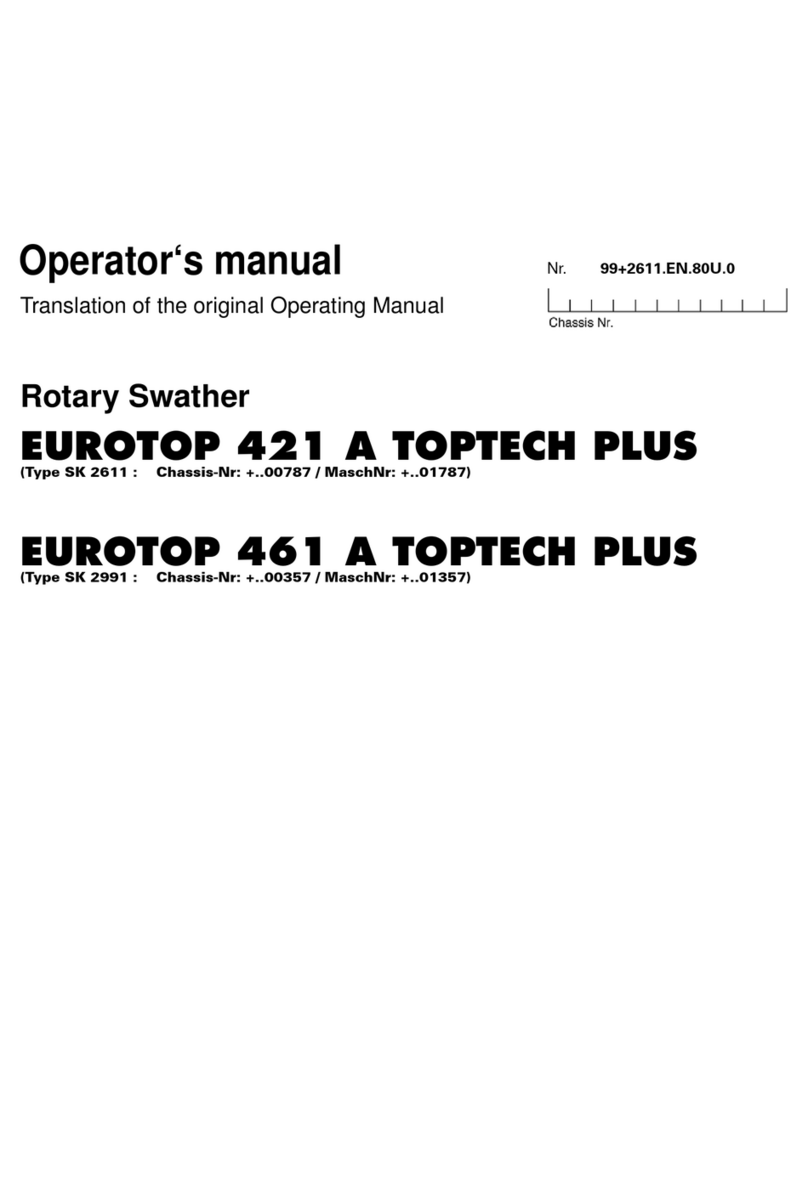
Poettinger
Poettinger EUROTOP 421 A TOPTECH PLUS Operator's manual

